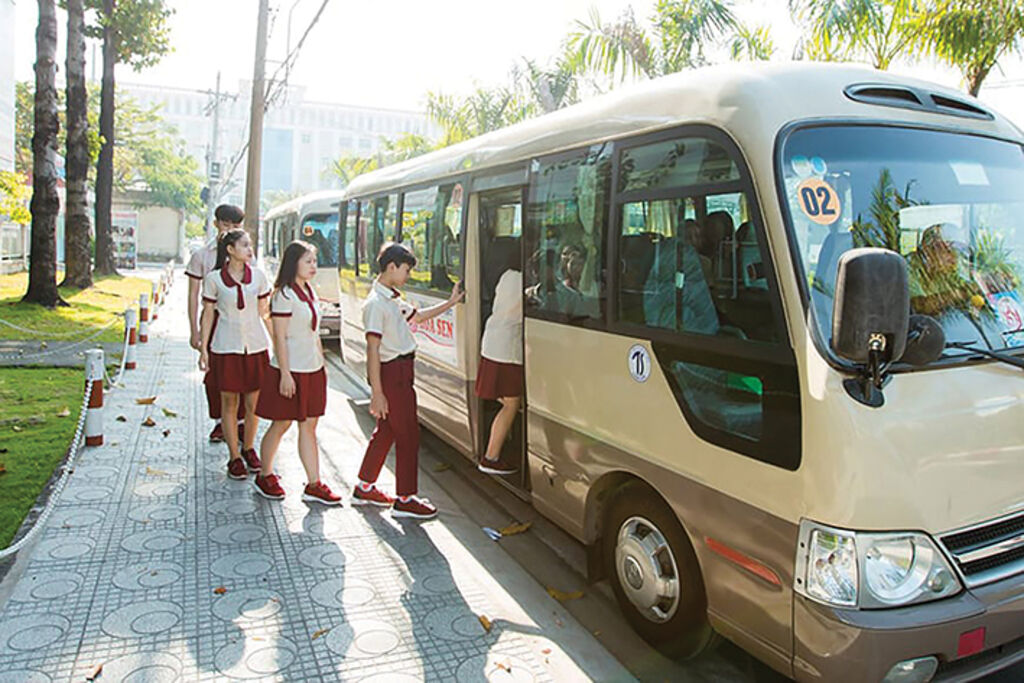 |
| Pupils embark on a school bus in Cau Giay district, Hanoi__Photo: https://phapluatxahoi.kinhtedothi.vn |
The Ministry of Transport has recently released a draft national technical regulation on technical safety quality and environmental protection applicable to automobiles with specific and strict safety requirements on vehicles used to transport schoolchildren.
This shows the efforts to further ensure safety for children on the way from home to school and back. Earlier, both the draft Law on Road and the draft Law on Road Traffic Order and Safety proposed imposing stringent safety conditions on school bus services.
In Vietnam today, school transportation services have become more and more popular. In Hanoi alone, there are currently more than 2,000 school buses, not to mention the fact that tens of thousands of students often use public transport bus services. In big cities around the country, the demand for school bus services is incrementally increasing. However, school bus safety remains a top concern for most parents.
In August 2019, the country was shocked by the death of a first-grader in Hanoi after he was abandoned in school bus for nine hours. In September 2020, a nine-year-old boy in the capital city fell asleep on the way home to school and was left alone on school bus. Fortunately, he managed to open the car door from inside and showed up to class before anyone noticed his absence. Regarding traffic accidents involving school buses, in November 2019, three primary pupils in the southern province of Dong Nai fell off a running shuttle bus. Luckily, there were no other moving vehicles in the vicinity and the children were unhurt. In 2021, a similar accident occurred in the highlands province of Dak Lak but the victim, a 12-year-old student, was not that lucky. The kid died immediately after falling from the open door of a moving school bus.
Stringent safety requirements
In order to further improve safety and prevent incidents involving school buses, a raft of regulations have been proposed. According to the draft national technical regulation on technical safety quality and environmental protection for automobiles, in addition to general requirements, vehicles used to transport students must meet some more conditions.
Specifically, school buses must be painted in dark yellow on the outside and stuck with the school bus sign at the front and on both sides above the windows. The rear of the vehicles must be fitted with the stop sign and signals to warn other vehicles not to pass when students are embarking or disembarking. The vehicles must be equipped with interior rear-view mirrors and CCTV systems for monitoring both the passenger and driver cabins as well as with external cameras for monitoring activities around bus doors during student pick-up and drop-off.
The regulation also requires school buses to have a siren or an emergency alarm system to warn if students are left unattended in the vehicle for more than 15 minutes. First aid kits, emergency warning switches and fire extinguishers would also be needed.
In addition, school buses must be fitted with a speed limiter to prevent them from exceeding the maximum allowable speed of 80km/h. The number of students on each bus must not exceed 45, for preschoolers, or 56, for primary and lower secondary school pupils.
According to the draft Law on Road, student transportation activities may be carried out by either education institutions or transport service providers. However, in any case, the law-prescribed conditions must be met. For example, school bus drivers must have at least two years’ experience in passenger transport.
As per the draft Law on Road Traffic Order and Safety, the service life of vehicles used to transport students must not exceed 15 years. The draft law also specifies that priority would be given to school buses in traffic diversion and direction. In addition, local administrations would be required to arrange pick-up/drop-off zones at schools and along the bus routes.
Concerns about feasibility
Nguyen Van Cong, who has two kids studying in Marie Curie Lower Secondary School in Hanoi, appreciates the tentative regulations. He told the Quan doi Nhan dan: “My children’s school has applied many specific internal regulations on shuttle bus. In addition to the driver, there is always a teacher on the bus and every day she sends image or text messages to notify parents when their child gets on and off the bus. However, I can hardly say that I’m completely reassured. So I strongly agree with authorities’ intention to devise specific regulations on school bus operations.”
Not only parents but also education administrators and transport businesses agree with the tightening of regulations on student transportation.
Dr. Ha Thi Kim Sa, Chairwoman of the School Council of Hong Ha Secondary and High School in Ho Chi Minh City, told the Tuoi Tre that she supported tightened regulations as “they would help minimize operational risks in provision of school bus services.”
Nevertheless, from another point of view, the feasibility of these regulations remains a concern. It is worth mentioning that many schools now do not maintain their own school bus fleet but outsource student transportation to transport businesses. Hence, once these regulations are approved, the cost of student transportation services would go up.
“If shuttle bus businesses reluctantly increase service charges, maybe parents will no longer choose their service, otherwise, they will be the ones who bear this additional cost. I think if regulations on school buses come into existence, should there be preferential policies for school transportation service providers? It is because in reality, as school start and end times of most education institutions are nearly coincidental, a bus fleet can only serve one school, while it is difficult for them to undertake additional transport contracts outside school hours, especially when vehicles are painted dark yellow,” Dr. Sa analyzed.
Do Van Tinh from a transport business providing shuttle bus services for many private schools in Hanoi also praised the efforts to further guarantee safety in student transportation. “These proposals aim to distinguish school buses from other commercial passenger vehicles, improve quality, ensure safety, and enhance responsibility of service providers and schools. However, all school buses now have school logos painted on their sides and at the front, so in my opinion, it is unnecessary to require an exclusive paint color for them,” he said
Dr. Khuong Kim Tao, former Deputy Chief of the Office of the National Traffic Safety Committee, shared another viewpoint. “If these regulations are enacted, businesses would have to procure more safety equipment for vehicles and provide supplementary training to bus drivers and attendants and this would lead to an increase in their service costs. But if not, it will be hard to encourage businesses to pour money to upgrade vehicles and equip safety devices,” the traffic safety expert was quoted by the Quan doi Nhan dan as saying.
“In my opinion, any driver will willingly give way when seeing school buses. Hence, if conditions permit, we should provide a unified paint color to identify these vehicles. All tentative regulations are designed based on safety criteria. I think these regulations are feasible and not difficult to implement,” he added.-









